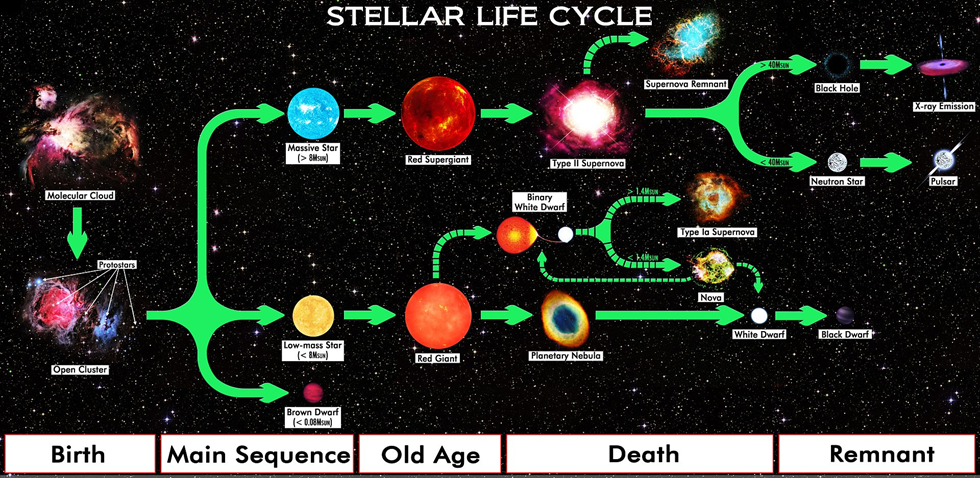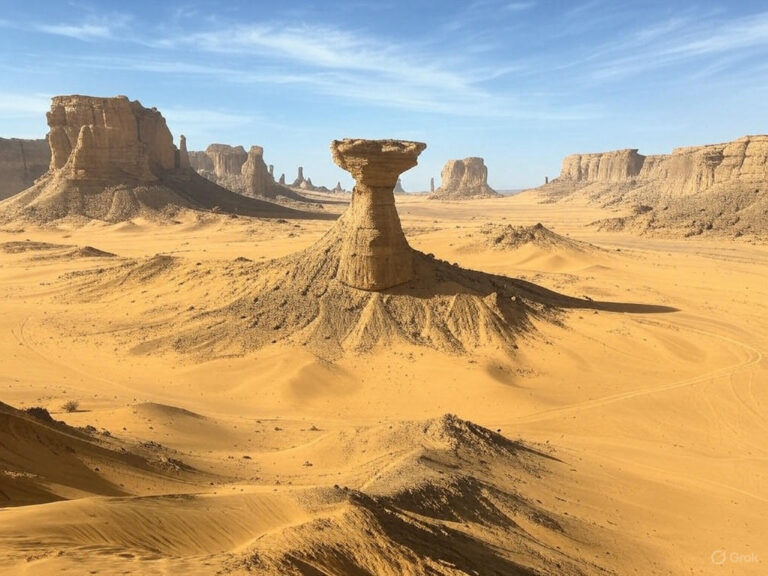Formation of Stars UPSC
Let’s begin by imagining this:
Just as humans are born, grow, age, and eventually die — stars too go through a life cycle, starting from birth in massive clouds of gas to dying as either white dwarfs, neutron stars, or black holes, depending on their initial mass.
Let’s now understand this entire cosmic life journey, step by step. Zoom in to the following chart and try to understand going through the discussion that follows. You can refer to the full size of the image here.

1. The Beginning: Nebula – The Cosmic Womb
Nebula is the birthplace of stars — a giant, cold cloud made mostly of hydrogen and helium, with some dust mixed in.
- Gravity begins pulling particles inward.
- Over time, the cloud condenses and collapses under its own gravity.
- This process forms the Protostar.
2. Protostar – The Star That’s Not Yet a Star
A Protostar is like an unborn baby — it looks like a star but hasn’t started living yet.
- No nuclear fusion is happening in the core.
- All the light and heat it emits come from gravitational contraction.
- Surrounded by dust, protostars are hard to detect in visible light — only infrared or radio telescopes can spot them.
3. T Tauri Star – Teenage Star
Think of the T Tauri stage as adolescence — the star is unstable and still contracting.
- It hasn’t yet entered the stable phase of life.
- Nuclear fusion hasn’t fully begun, but it’s on the verge.
- This stage occurs before a low-mass star becomes a main sequence star.
4. Main Sequence Star – Adulthood Begins
Now the star is in its prime of life.
- Hydrogen atoms fuse into helium in the core — a process that releases huge energy.
- Our Sun is a main sequence star, and 90% of all stars are in this stage.
- It’s a stable phase — gravity pulling in is balanced by the outward pressure from fusion.
🔹 Red Dwarfs:
- Smallest, coolest, faintest of the main sequence stars.
- Make up ~75% of Milky Way’s stars.
- Not visible to naked eye.
- Example: Proxima Centauri (our nearest star after the Sun).
5. The Aging Star: Red Giant or Red Supergiant
As the hydrogen fuel runs out, fusion in the core slows, and gravity starts to dominate.
- The core contracts, heats up, and starts fusing hydrogen in a shell around it.
- This causes the outer layers to expand outward, forming a Red Giant (small star) or a Red Supergiant (massive star).
- These stars are larger in size, cooler on the surface, but brighter due to their massive volume.
- They start fusing helium into carbon and other heavy elements.
📌 This is how the elements in the periodic table were formed — inside stars!
6. Degenerate Matter – The Collapse Begins
As fusion halts, gravity takes over again.
Now the matter inside becomes so dense that atoms compress beyond normal limits, forming degenerate matter.
- Electrons are pushed closer to the nucleus, reducing the atom’s size.
- This extremely dense state is seen in white dwarfs and neutron stars.
7. The Final Act: Star’s Death Depends on Mass
A. For Small Stars (like the Sun):
🔹 Planetary Nebula
- Outer layers are shed as a glowing shell of gas and dust.
- Despite the name, no planets are involved.
🔹 White Dwarf
- The collapsed, dense, hot core that remains.
- Made of degenerate matter, size of Earth but mass of Sun.
- Extremely dense — a spoonful weighs several tonnes.
🔹 Black Dwarf (Theoretical)
- A white dwarf that has cooled down completely.
- But since this process takes longer than the current age of the universe, no black dwarfs exist yet.
B. For Massive Stars:
🔹 Red Supergiant → undergoes a Supernova
- A gigantic explosion that disperses outer layers and creates heavier elements.
- One of the most violent events in the universe.
🔹 After Supernova:
- If mass is less: forms a Neutron Star.
- If mass is more: forms a Black Hole.
Nova – A Sudden Flare-Up
A Nova occurs when a white dwarf in a binary system pulls hydrogen from its companion star.
- This material builds up and suddenly undergoes fusion — causing a sudden brightening of the star.
- It’s a temporary outburst — not to be confused with supernova.
Similar but Different: Brown Dwarfs
Brown dwarfs are failed stars.
- They form like stars — from collapsing gas and dust — but their mass is too low to trigger nuclear fusion.
- Too big to be called planets, too small to be stars.
They are like the misfits of the cosmos — existing in between.
So, with this we have roughly completed the stellar evolution of a star, now let’s discuss the supernova concept in a greater detail.
Supernova – A Star’s Explosive Death
When a massive star reaches the end of its life, it doesn’t just fade — it explodes.
- This explosion is called a Supernova — and for a brief time, it can outshine an entire galaxy, emitting brightness equal to 100 million Suns.
- It sends a shockwave into surrounding space, causing nearby nebulae to condense — and start the formation of new stars.
📌 The universe is a recycling system — for one star to be born, another must die.
Types of Supernovae
There are two primary types, based on the cause of explosion:
✅ Type I Supernova (Type Ia)
Occurs in binary star systems involving a white dwarf.
- The white dwarf steals hydrogen gas from its companion star.
- This increases the temperature and pressure, triggering runaway carbon fusion.
- The entire star blows apart.
🔸 Significance:
- All Type Ia supernovae reach roughly the same peak brightness.
- This uniformity makes them standard candles — useful for measuring distances in space and determining the expansion rate of the universe.
✅ Type II Supernova
Occurs in massive single stars, especially red supergiants.
- When fusion stops (mostly iron is left), gravity suddenly collapses the core.
- This collapse releases enormous energy, leading to an explosive blast.
- The outer layers are thrown into space; the core is either left as a neutron star or collapses into a black hole.
📊 Nova vs Type I Supernova – Key Differences
| Feature | Nova | Type I Supernova |
| Explosion Strength | Can shine 1 million times brighter | Can shine as bright as a galaxy |
| Star Survives? | Yes (can repeat cycles) | No (star is completely destroyed) |
| Cause | Surface fusion on white dwarf | Runaway carbon fusion inside white dwarf |
Importance of Supernovae – The Universe’s Foundry
Supernovae are not just explosions — they are the factories of elements.
- In later stages of a star’s life, it fuses helium into carbon, and further fusion creates elements up to iron.
- But elements heavier than iron (like gold, uranium) need even more energy, which comes only during a supernova.
- These elements are blasted into space, enriching the interstellar medium and forming the raw material for new stars, planets, and life itself.
🌍 So, the iron in your blood and the gold in your ring — all were made inside a dying star.
What Happens After a Supernova?
The fate of the remaining stellar core depends on its mass.
🔹 A. Neutron Star – The Cosmic Atom Core
After a Type II supernova, if the remaining core’s mass is moderate, it compresses into a Neutron Star.
- At this stage, electrons and protons fuse into neutrons.
- The core is ultra-dense — imagine 3 Suns packed into a sphere just 20 km wide.
- If any more massive, it would collapse into a black hole.
📌 Chandrasekhar Limit:
If a dying star’s core exceeds 1.4 solar masses, it cannot become a white dwarf — it will collapse into a neutron star or a black hole.
🔹 B. Black Hole – The Cosmic Abyss
If the core is extremely massive, gravity causes a total collapse — forming a black hole.
- In a black hole, gravity is so strong that even light cannot escape.
- The matter is crushed to an infinitely dense point (singularity), and time and space themselves are distorted.
📌 We cannot see a black hole directly, but we detect it by its effect on nearby stars and light (gravitational lensing, x-ray emissions).
- They suck in nearby matter, including stars — becoming cosmic vacuum cleaners.
Stellar Evolution Table:
| Stage | Pathway | Mass Category | Key Events | Final Fate |
| 1. Molecular Cloud | Initial star-forming region | All stars | Cold gas and dust collapses under gravity to form protostars | Proceeds to Protostar |
| 2. Protostar | Early stage of star formation | All stars | Heating due to contraction; fusion not started yet | Proceeds to Main Sequence |
| 3. Main Sequence | Core hydrogen fusion (stable phase) | Low-mass: < 8 M☉ High-mass: > 8 M☉ | Longest phase in a star’s life where H → He | Becomes Red Giant or Red Supergiant |
| 4. Red Giant | Old age stage after hydrogen depletion | Low-mass stars (< 8 M☉) | Helium fusion in shell; expansion of outer layers | Leads to Planetary Nebula |
| 4. Red Supergiant | Massive star’s aging phase | High-mass stars (> 8 M☉) | Helium and heavier element fusion; iron forms in the core | Leads to Type II Supernova |
| 5. Planetary Nebula | Outer layers ejected | Low-mass stars | Gas shell expelled; core remains | Leaves behind a White Dwarf |
| 5. Type II Supernova | Core-collapse explosion | High-mass stars | Star explodes violently; elements scattered | Remnant becomes Neutron Star or Black Hole |
| 6. White Dwarf | Stellar remnant (no fusion) | Low-mass stars | Dense, Earth-sized; slowly cooling | May form Black Dwarf (hypothetical) |
| 6. Neutron Star | Supernova remnant core | 1.4–3 M☉ (Chandrasekhar Limit) | Dense neutron-packed core | May be observed as Pulsar |
| 6. Black Hole | Supernova remnant core | > 3 M☉ | Collapse to a point with infinite density; no light escapes | Final state of most massive stars |
| Brown Dwarf | Failed star | < 0.08 M☉ | Not massive enough for nuclear fusion | Remains a substellar object |
| Binary White Dwarf System | Two stars orbiting closely | Low-mass binary | Material transferred to White Dwarf from companion | May trigger Nova or Type Ia Supernova |
| Nova | Surface explosion on White Dwarf | Binary with accretion | Sudden fusion on surface due to gas accumulation | White Dwarf survives (can repeat) |
| Type Ia Supernova | Total destruction of White Dwarf | Binary White Dwarf > 1.4 M☉ | Runaway carbon fusion; used as standard candles for cosmic distances | No remnant left |
Note: 1 M☉ = Mass of the Sun = 1.989 × 10³⁰ kilograms
Quick Classification by Star Mass:
| Star Mass | Evolutionary Path |
| < 0.08 M☉ | Brown Dwarf → No fusion → Fades |
| 0.08 – 8 M☉ | Protostar → Main Sequence → Red Giant → Planetary Nebula → White Dwarf → (Black Dwarf) |
| > 8 – 40 M☉ | Protostar → Main Sequence → Red Supergiant → Type II Supernova → Neutron Star |
| > 40 M☉ | Protostar → Main Sequence → Red Supergiant → Type II Supernova → Black Hole |




